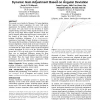Free Online Productivity Tools
i2Speak
i2Symbol
i2OCR
iTex2Img
iWeb2Print
iWeb2Shot
i2Type
iPdf2Split
iPdf2Merge
i2Bopomofo
i2Arabic
i2Style
i2Image
i2PDF
iLatex2Rtf
Sci2ools
CHI
2009
ACM
2009
ACM
The angle mouse: target-agnostic dynamic gain adjustment based on angular deviation
We present a novel method of dynamic C-D gain adaptation that improves target acquisition for users with motor impairments. Our method, called the Angle Mouse, adjusts the mouse C-D gain based on the deviation of angles sampled during movement. When angular deviation is low, the gain is kept high. When angular deviation is high, the gain is dropped, making the target bigger in motor-space. A key feature of the Angle Mouse is that, unlike most pointing facilitation techniques, it is target-agnostic, requiring no knowledge of target locations or dimensions. This means that the problem of distractor targets is avoided because adaptation is based solely on the user's behavior. In a study of 16 people, 8 of which had motor impairments, we found that the Angle Mouse improved motor-impaired pointing throughput by 10.3% over the Windows default
| Added | 24 Nov 2009 |
| Updated | 24 Nov 2009 |
| Type | Conference |
| Year | 2009 |
| Where | CHI |
| Authors | Jacob O. Wobbrock, James Fogarty, Shih-Yen (Sean) Liu, Shunichi Kimuro, Susumu Harada |
Comments (0)

